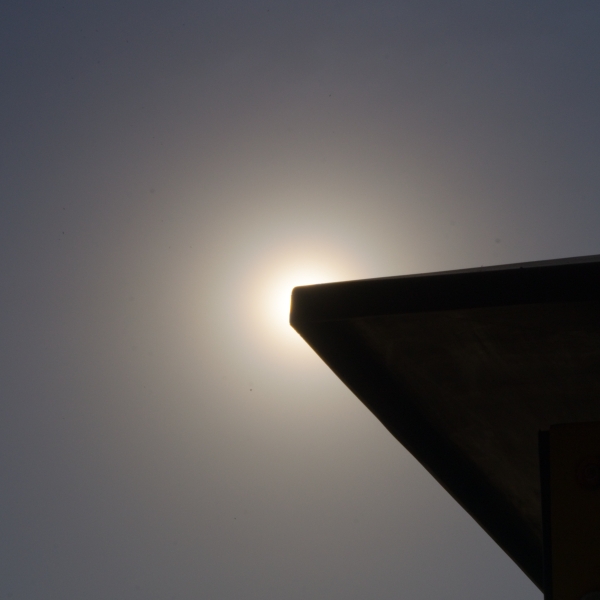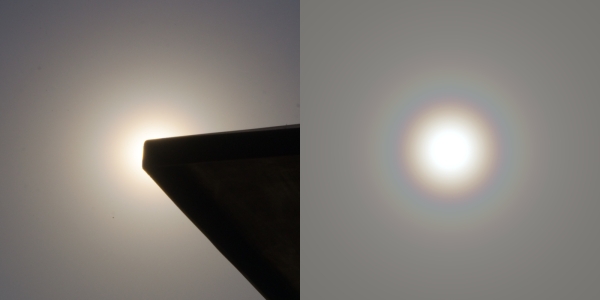Blog Archives
Olea europaea pollen corona
During the days of the 12th Light & Color in nature meeting (May 31st-June 3rd, 2016) in Granada, Spain, I noticed almost constantly a diffuse aureole around the sun, appearing against the background of a clear sky:

previous picture unsharp masked
All photos were cropped to a common viewing angle of 15° x 15° and the color saturation was increased.
Because of the dry and often cloudless summer weather we had back then, it seems unlikely that any kind of water drops did cause the phenomenon. On the other hand, the angular radius was way too small for Bishop’s ring, which at first seemed to be a plausible option as we had observed some haze towards Africa shortly before our plane landed in Malaga on May 30th.
No pronounced color pattern was visible to the naked eye, nor through a gray filter, but the saturation increase in the image processing revealed a typical corona structure with alternating colors. Thinking of pollen as possible scattering particles, the large amount of olive trees (olea europaea) in Andalusia immediately comes to mind. Furthermore, we witnessed ourselves that the olive trees were blooming these days when we visited a grove at Monachil in the vicinity of Granada – some of the visitors’ shirts or backpacks got covered with green dust after coming too close to the trees.

The olive grove at Monachil with the Sierra Nevada in the background (June 2nd, 2016)

A blooming olive twig from a tree in this grove (June 2nd, 2016, photographed by Hironobu Iwabuchi)
In order to check this hypothesis I looked up the shape and size of olive pollen: They are almost spherical with a mean polar diameter of 20.1 µm and mean equatorial diameter of 21.5 µm. For most of the observations, the sun elevation was high enough to simply approximate the pollen as spheres of 21.5 µm in size. I calculated the resulting corona from the solar spectrum using simple diffraction theory (which at this particle sizes is justified):
Both the photograph and the simulation (right hand side) were cropped to a field of view of 10° x 10°. For the simulation, I assumed a relative spread in the pollen size (standard deviation of a Gaussian distribution divided by the mean diameter) of 15%, convoluted the result with the sun’s disk and added a gray background. It matches the photograph quite well, though the contrast of the natural corona remains lower than that of the simulation. Maybe there were other scattering particles with a broader size distribution present, which added another, rather colorless aureole “layer” on top of the pollen corona, thereby diminishing its contrast. Surprisingly, I could not find any previous reports about “olive pollen coronae”, though the phenomenon should be quite prominent during the right season in the olive-growing regions.
Pollen corona in Deventer, The Netherlands
On April 1st 2009, Peter Paul Hattinga Verschure observed beautiful pollen coronae from his garden in Deventer, The Netherlands. Every time the wind blew through the pine trees, a cloud of pollen was blown away from them. When these clouds of pollen passed exactly in front of the sun, a beautiful pollen corona appeared. So, in one second it was bright and had three rings, in the next moment it disappeared again.
Pine pollen corona in Finland
Continuing on the favorite topic of pollen coronas, here are two rather painstakenly constructed images of pine pollen corona.
The white dots are wind dispersing seeds, probably of some willow species. They are more abundant in the lower image, which was taken in town. The upper image was shot in the midst of pine heath, with correspondingly less white fluffs in the air.
[Posted by Marko Riikonen]
Pollen corona during total eclipse
A pollen corona was seen by several observers at the Southern coast of Turkey during the total solar eclipse of 29th March 2006. This nice picture taken by Emma Herranen shows the atmospheric pollen corona with three colour segments only a few seconds before the second contact, as illuminated by the diamond ring phenomenon. The inner parts of the solar corona are seen as a white circle around the Moon.
Cedar Pollen Corona
I saw this extremely splendid cedar pollen corona on May 19, 2005 at Hachioji, Tokyo. Last year, the amount of cedar pollen was so large that we could observe some beautiful coronae (but it was a nightmare for people caught by hay fever).
Cypress pollen is another source of pollen coronae in Japan. However, the season of Japanese cypress pollen is almost same as that of our cedar pollen so that it is hard to distinguish its contribution from the cedar pollen”s contribution. (The amount of cypress pollen is less than cedar pollen.)
Posted by Yuji Ayatsuka
Pollen Corona by a False Acacia
In Japan, pollen coronae are normally caused by ceder pollen (and possibly Japanese cypress pollen). However, a pollen corona by a false acacia is observed by Mr. Yasuike on May 25th 2006, in Matsumoto. He said that an amount of false acacia pollen is quite large in this season around Matsumoto (it is not typical for the other areas in Japan).
It might be the first report of a pollen corona in Japan, other than by ceder (or cypress) pollen.
[Posted by Yuji Ayatsuka]
Alder corona with iridescence and cloud rays
The 27th of March was in a manner of speaking one of our first warm days this year. Owing to the long and cold winter together with the abrupt change the plants exploded into life and produced a very strong pollen concentration in the air. The humidity was very low and so the resulting pollen coronae stood out against the dry sky. The coronae originated from from alders which are very common in the area (Barsinghausen, near Hannover). Hazel were also flowering at that time but would have made a different form of corona.
That day Reinhard Nitze took very unusual pictures of the alder coronae. On the one hand the coronae were intense but appeared together with another phenomena, e.g. with iridescence clouds or cloud rays. Sometimes, however, Reinhard saw them “undecorated”.
Pollen Corona produced by hop blooms
Middle Europe we see pollen coronae produced primarily by birch, spruce, pine, hazel and alder. However, by deliberately shaking the bushes to discharge clouds of pollen it is possible to generate other types of coronae. In this example Karl Kaiser photographed a coronae from male hop blooms. Other pollen coronae by Karl are here.
Small and large coronas
How small is a pollen corona! On 14 May, a fine circular pollen corona re-appeared in clear sky blue over Deventer. It was magnified by zooming the camera lens, but actually real proportions of this small phenomenon are disguised by doing so. Here we see a fraction of a common water droplet corona in Fractocumulus too, left in the image. It is nice to see the differences in corona proportions, by considering pollencoronas, via common cloud coronas, to Bishops’ ring….
Posted by Peter-Paul Hattinga Verschure
Pollen corona
During the very dry weather of the last week, predominantly faint circular pollen coronas were continuously visible from the Netherlands. On 12 and 13 May the pollen was considerably washed out by short rain showers and could easily be collected afterwards. The image shows some pollen grains taken with simple eqiupment, a small microscope and a digital camera pointed through the eyepiece. The diameter of the field is 1,0 mm. The pollen can be identified as that from pine-trees. After the first rain shower, the pollen corona appeared much better defined than before, being circular with threefold red.

Posted by Peter-Paul Hattinga Verschure














